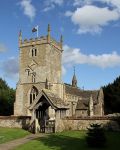South Marston is a village and civil parish in the Borough of Swindon, Wiltshire, England. The village is about 3 miles (5 km) north-east of Swindon town, where many of its inhabitants work or attend school.
History
The earliest documentary evidence for continuous settlement dates from the 13th century, but there is fragmentary archaeological evidence of occupation as far back as the Bronze Age.
It is claimed that there were Roman remains just outside South Marston in a field belonging to Rowborough Farm, but these have long disappeared. Ermin Way, a major Roman road linking Silchester and Gloucester, passed close to the village on the south-west side, separating it from Stratton St Margaret. There was a Roman station at Durocornovium, now Covingham, one mile south of the village.
The name "Marston" derives from a common Old English toponym meaning "marsh farm". This suggests that the village was founded before the Norman conquest of England in 1066, although it is not recorded in the Domesday Book of 1086. Documentary evidence of the village exists from about 1280, when it is mentioned as part of Highworth Hundred.
South Marston became a civil parish in 1894. For church purposes, South Marston was a chapelry of Highworth until it became a separate church parish in 1889.
